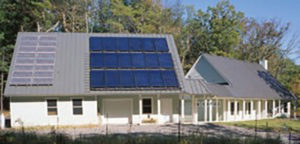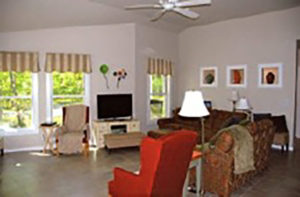By HECTOR MUNOZ-BARAS, AIA, NCARB, LEEDap August 1, 2012


Architects hold a unique position in the creative fields: Their work is wholly dependent on their clients’ budgets and inclinations, and unlike an artist who paints or sculpts their own creative vision and then hopes to find a receptive patron to buy their art, an architect must help develop a client’s vision. A good client is the foundation of a successful project, and that certainly was the case with our recent off-grid house project in upstate New York.
When the clients approached us a few years back to design a weekend getaway/future retirement home, they had two priorities: being more than a mile and a half (2.4 kilometers) from the utility grid, the energy requirements of the house had to be generated on site; and they wanted a home first and foremost, not a renewable energy machine. Not only was the couple familiar with renewable energy, but they were even willing to try an innovative solar thermal sand bed for radiant heating — a concept I shared with them from the pages of SOLAR TODAY. We managed to incorporate all of these features into a beautiful, near-net-zero-energy home, while maintaining the place of technology at the service of the client. Architecture should always place the individual, as observer and participant, at the center of the discussion, and we achieved that, using solar energy as the means.
Leading with the Project Site

The 80-plus acres (0.3 square kilometers) had been in the family for decades, and the couple envisioned a new weekend/future retirement home there to replace an old cabin powered by a photovoltaic (PV) panel. The site includes a pristine 15-acre lake, so among the clients’ priorities was to take advantage of the spectacular views.
The clients also had some programmatic requirements: a 1,500-square-foot (140-square-meter) home consisting of two bedrooms, two baths, a three-season room, oversized garage (for assorted vehicle and toys) and customary room types. Optimally the house would be sited on the north side of the lake facing south, but optimum is seldom the case in the real world. Our site places the home west of the lake, facing east. On the other hand, any good architect will tell you that every obstacle provides an equivalent opportunity. The less-than-perfect siting that was required to meet the clients’ programmatic requests led to the first design choice.
The large garage roof provided an excellent surface area for both the PV and solar water- heating collectors. Bifurcating the two main functional areas (living and garage), the orientation of the two building masses could be optimized for their specific purposes. As shown by the site plan (right), we oriented the garage mass true south, while we placed the residential building 30 degrees off south to engage the lake view. At 30 degrees off true south, the passive solar gain is diminished by only +/-18 percent. As this is a heavily wooded site, a large area south of the house needed to be cleared. The hardwood trees of oak, ash and maple are providing the first several years of firewood for the living room stove. After we determined orientation, the next step was the disposition of the interior and exterior spaces.
Designing the Spaces

The first principle of passive solar design is to have as many “living” areas as possible on the southern side of the building, allowing the south-facing windows to provide direct solar gain.
For maximum southerly exposure, the 24- by 74-foot (7- by 23-meter) building was oriented with the long axis perpendicular to the sun. The two bedrooms, open great room and three- season room are on the southeast-facing side of the house. A walk-in closet is on the northwest corner, while the bathrooms and laundry room are on the north wall. The mechanical room is isolated in the center, conveniently adjacent to both laundry and kitchen. Having the mechanical room centralized and adjacent to the “wet” areas is not critical, but given that the entire home’s energy (both heat and power) is generated on site and any loss is to be avoided, this layout minimizes that loss.

As you can see on the site plan, the great room, three-season room and the patio are oriented toward the lake. We did make some compromises to give the clients the spectacular viewing experience they desired. The great room has a cathedral ceiling, and of course that means a greater volume of space to heat, but we sacrificed energy efficiency here to contribute to the home’s spatial and textural richness. The southeastern wall of windows is rotated an additional 20 degrees, affording an expansive view of the lake.
The layout of the windows places 57 percent of the glazing on the southern and southeastern exposure. Eighteen percent of the windows face north and west, while the remaining 25 percent face east. As beneficial as this glazing is during the winter, with a 41° 29’ 13” latitude, extra solar gain is not generally helpful in the summer! At this latitude, an overhang of about 3 feet (0.9 meter) is the usual design response to mitigate that solar gain, and in this case, a covered walkway with columns connects the front door to the detached garage. This provides a double function of keeping the sun out in the summer and providing protection from the rain and snow between the garage and house.
With the home’s major organization in place, our next decision began to inform the massing of the buildings for insulation. Given the latitude, we selected a 12/12 pitch to provide a good average solar-collecting angle for the arrays.
Selecting Efficient Construction Materials

The first rule in energy efficiency: Make it tight. To that end, the house is constructed of ICFs (insulated concrete forms) for its below-grade solar thermal mass collector (a sand bed) for radiant floor heating throughout the house, and 5-1/2-inch-thick closed-cell polyurethane SIPs (structural insulated panels) for the exterior walls (R-33). We originally intended to use SIPS on the roof, but due to budgetary constraints, we used R-49 fiberglass insulation instead.
The house has a slab on grade. Roof trusses span the whole house, from the front walkway to the rear covered walk. The windows have a U value of 0.29. The interior construction of the house is of standard northeast type, with a few unique features primarily in the mechanical and appliance areas. The refrigerator is powered by propane, and at the suggestion of the client, the lights and outlets can be shut off by a few switches accessible from the rooms — not just from the panel box. Given that all the electricity is provided by the battery array, any and all power “phantoms” must be eliminated. That means no night-lights, alarm clocks or coffee makers with built-in clocks! A wood stove in the great room provides a secondary heat source, with a backup of an instant water heater fired by propane when the solar water heater and corresponding thermal mass storage fail to maintain the temperature at the required levels.
Designing the Solar Energy Systems
Below the house’s concrete slab is a 6-foot-deep (1.8-meter-deep) insulated sand bed with PEX tubing running throughout. This is almost 11 tons of mass. As mentioned, this thermal mass storage system consists of walls made of an 8-inch concrete core within the ICF, 2-1/2 inches of molded expanded polystyrene on both sides (R-11.35), plus 6 inches of Dow “blueboard” at the base and another 6 inches of blueboard just below the slab (each having an R-12 value). The system is based on the concept described in Bob Ramlow’s article, “Warm Radiant Comfort in the Sand,” from the November/December 2007 SOLAR TODAY. I gave this article to the client and, having an engineering background, he immediately understood the design’s efficacy.

Monitors connected to a computer-controlled system gauge the temperature at the sand bed, and in the heating season it calls out for heat to be pumped from the sand bed once the solar water-heating panels can no longer directly keep up with the demand. According to the client, that occurs when there is no sun for several days or when the temperature outside stays low for a week or so. Initially the heated glycol from the solar panels transfers its heat into the domestic hot water tanks. After the water in the tanks reaches 115°F (46°C), the temperature adequate for heating the radiant floor, the glycol is shunted to the sand bed below the house to reheat the sand bed. Pumps circulate the glycol through the 18 flat-plate solar panels and the sand bed. It takes about six to eight weeks to charge the sand bed.
Although the standing seam metal roof would have been ideal for a thin-film installation, we selected crystalline PV panels for their higher efficiency. The array is capable of producing 5.5 kWp but once the batteries are fully charged, any unused power cannot be stored. That’s a common problem so long as the house is used only on weekends. Being off the grid, the system includes 16 deep-cycle, flooded lead acid batteries. The battery storage is in a separate room in the garage, with the batteries feeding to the house below grade, as do all the glycol feeds. The feeds themselves are 4 feet (1.2 meter) below grade in an R-30 insulated sleeve.
Being that the house is extremely tight (no air blower test has been done), an air-to-air heat exchanger provides fresh make-up air with minimal heat loss in the conditioned air. Lighting is all low-wattage CFLs. The clients have a good idea of the home’s performance, now that they have occupied it through two heating seasons.
Assessing, Refining Performance
So, how does the house perform? Total energy cost consists of one item — propane. As noted, a propane-fired instant water heater is connected to the radiant heating system in the event that the direct and stored heat are inadequate. This can be considered the tertiary backup, since the wood-burning stove is used regularly. Propane is used for cooking and refrigeration, and the homeowners report an average use of about 300 gallons (1,136 liters) per year, which equates to about $100 per month for energy. This number also includes the energy to heat the 510 square feet (47 square meters) of additional space over the garage. The garage, with its office/guest area, was built of “conventional” stick construction with a small propane-fired boiler to provide heat. Were it not for this extra energy load, the average energy usage in the home alone would be less than three-quarters of a gallon (3 liters) of propane per day.

The singular aspect of this project, the mass heat-storage system, works well until the heat is depleted, which occurs around mid-January. At that point in the heating season, the solar energy is being used quicker than it can be collected — due of course to the shorter days and the lower sun angles. When fully charged, gauges in the sand bed indicate that temperatures reach over 160°F (71°C).
Even at the height of summer for a few muggy nights, the homeowners have had enough power to operate a small air conditioner in the house. The air-to-air exchanger keeps the air fresh, and the house has performed as intended. Power has been more than adequate.
 After living in the house almost two years, both the wife and husband say they wouldn’t change a thing in the house. In terms of the energy systems, however, we have learned a few things. The thermal mass storage system does a great job of collecting, storing and releasing its heat energy as anticipated, but given the home’s energy specifics (size, insulation, air infiltration, site orientation, homeowner use), a greater mass storage volume is needed, as well as more insulation in the sand bed. The insulation value should probably be doubled on all four sides, while the volume for storage should be increased by another 50 percent. As we tweak these parameters, we expect to extend the sand bed’s functional use through March each heating season.
After living in the house almost two years, both the wife and husband say they wouldn’t change a thing in the house. In terms of the energy systems, however, we have learned a few things. The thermal mass storage system does a great job of collecting, storing and releasing its heat energy as anticipated, but given the home’s energy specifics (size, insulation, air infiltration, site orientation, homeowner use), a greater mass storage volume is needed, as well as more insulation in the sand bed. The insulation value should probably be doubled on all four sides, while the volume for storage should be increased by another 50 percent. As we tweak these parameters, we expect to extend the sand bed’s functional use through March each heating season.
 Architect Hector Muñoz-Baras, LEEDap, is the principle of V.Baras ARCHITECTS (vbaras.com), with offices in Port Jervis, N.Y., and New York City. His firm has a diverse practice designing both residential and commercial projects of all sizes. He received his M. Arch. from the University of Pennsylvania, where he studied with one of the early proponents and leaders of the solar movement, Donald Prowler. In addition to this off-grid house, Muñoz-Baras has designed an earth-bermed “green” greenhouse based on basic solar principles.
Architect Hector Muñoz-Baras, LEEDap, is the principle of V.Baras ARCHITECTS (vbaras.com), with offices in Port Jervis, N.Y., and New York City. His firm has a diverse practice designing both residential and commercial projects of all sizes. He received his M. Arch. from the University of Pennsylvania, where he studied with one of the early proponents and leaders of the solar movement, Donald Prowler. In addition to this off-grid house, Muñoz-Baras has designed an earth-bermed “green” greenhouse based on basic solar principles.
He has had a home LEED-certified Silver and is currently involved with an apartment building rehab, which will receive a LEED certification. Contact Muñoz-Baras at hector@vbaras.com.




